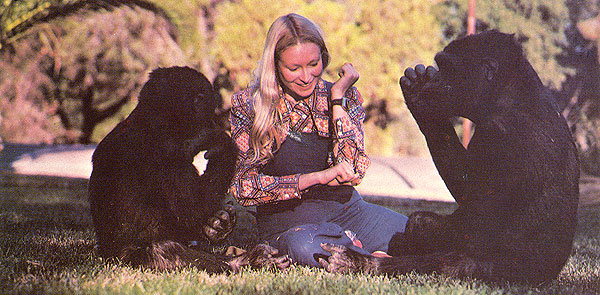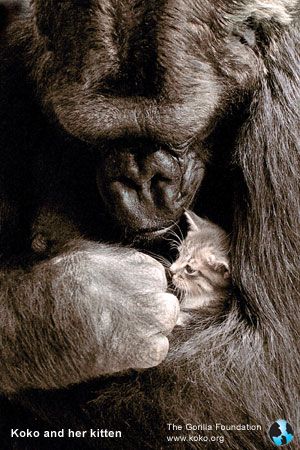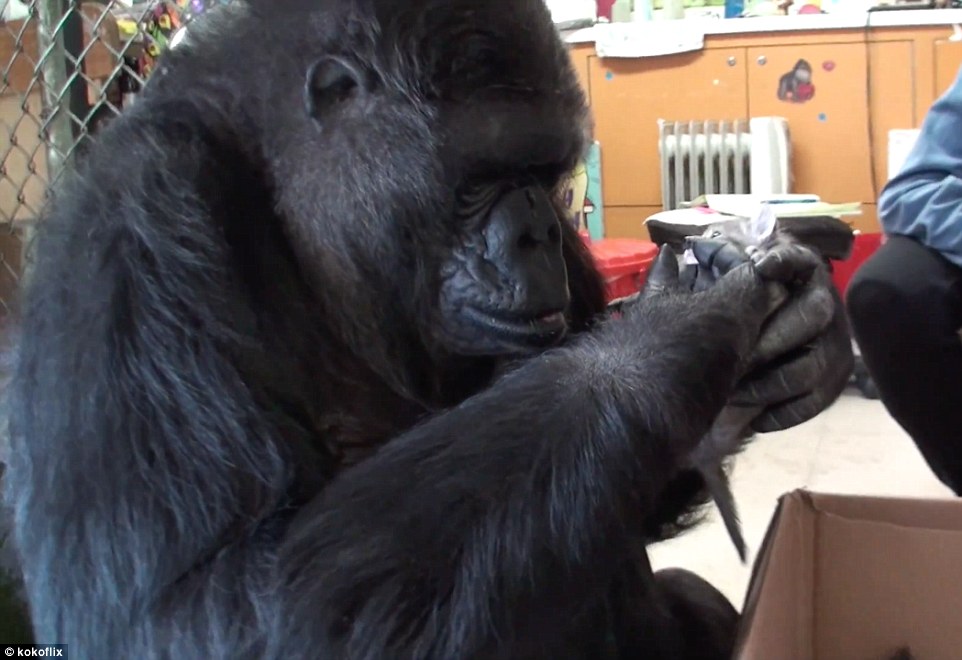Gorillas share 98.6% of the genetic material with humans. Like other species of animals, they communicate orally, visually, olfactorily and tactilely. As for the first form, several types of vocalizations have been identified. However, the gorilla Koko was and always will be,famous for being able to communicate with humans through sign language
Koko, a Western Lowland Gorilla (Gorilla gorilla subspecies gorilla), was born on July 4, 1971 at San Francisco Zoo. Dr. Francine Penny Patterson started to take care of her and teaching her the American Sign Language (ASL) when she was one year old. In fact, Koko learnt over 1500 words. She also tried to teach her to “read,” so Koko was able to recognize symbols and seemed to identify words. In addition, she demonstrated self-recognition in front of a mirror, a behavior that is being studied in other species of primates and other groups of animals.
Patterson received her PhD in Psychology from Stanford University in 1972. She wrote several books, including Koko’s Story and The Education of Koko. She has also published more than 40 scientific publications and she won several National Geographic awards. With Dr. Ronald Cohn and Barbara F. Hiller, they created the Gorilla Foundation in 1976. In recent decades, the foundation has focused on exploring the boundaries of interspecies communication (with the gorillas Koko, Michael and Ndume) to provide a basis for improved care of captive gorillas and to expand knowledge in order to accelerate the conservation of these species in the wild, as well as to disseminate education and empathy for animals. According to IUCN data from 2016, the species to which Koko belongs and the other gorilla species (Gorilla beringei) are Critically Endangered, that is, the previous category to “Extinct in nature”. One example of improved care of gorillas was given by Koko, when she learned to make the “pain” gesture and one day pointed to her mouth. Thanks to this, the doctors learned that the gorilla needed a dental extraction. Apart from that, she was in good health.

Did Koko understand the concept of death?
One of the visits that Koko received during her lifetime was from the actor Robin Williams in 2001, who recently passed away. They quickly got along very well. Robin even was able to make Koko laugh after more than 6 months of sadness due to the recent death of her colleague Michael, at the age of 27. When Robin died in 2014, Koko reacted sadly. According to her caregiver
“Robin’s ability to ‘talk’ with Koko was extraordinary and unforgettable to her”.
After Dr. Patterson received the terrible news by phone, she told Koko
“we have lost our dear friend Robin Williams”.
Immediately Koko stood still, very thoughtful, and said to her caregiver “cry, woman”. At the end of the day, the gorilla was very serious. As the Foundation rightly pointed out, this meeting was a great example of how humans and gorillas can overcome interspecific boundaries and express the highest form of empathy.

Did Koko really understand what her caregiver was trying to express? In an interview, Dr. Patterson said that one of the caregivers showed Koko a skeleton and asked her if it was alive or dead. The gorilla signed “dead, drapped”. Then the caregiver asked “where do the animals go when they die?”, and she said “to a comfortable hole” and threw a kiss goodbye. The doctor added that in many walks they saw dead birds and questioned her about it. In addition, when Koko was asked to talk about her own death or her companions’ death, the gorilla became restless and uncomfortable. On the other hand, it has been found that gorillas bury dead animals at least in zoos.
Another example where Koko seemed to understand the meaning of death was when one of the kittens she took in, called All Ball, passed away a few months later. In that moment, she signed “bad, sad, cry”. The extravagant name of this cat also has its story, one of the many that demonstrated the enormous intelligence of Koko. In fact, she was who coined that name. Koko met this cat on her fourth birthday. Dr. Patterson did not agree too much with this relationship because she feared that Koko might hurt him. However, the opposite happened. When Koko saw All Ball and the rest of the litter, she crouched down to the box where they were, she picked up the little grey one carefully and she signed “small”, “soft” and “all ball is name”, supposedly because the cat looked like a ball and Koko liked rhyming words. So the cat kept that name. But the amazing fact is that after 15 years of the cat’s death, when Koko saw a picture of another cat similar to her beloved All Ball, she expressed in sign language and pointing to the image: “sad, cry”.

After All Ball’s death, Koko had other cats like Lipstick, Smoky, Mo-Mo, Miss Gray and Miss Black. She met the latter two on her 44th birthday. During the first meeting, Koko signed “cat” followed by “baby”. Despite the difference in size between them, the gorilla was very careful with the young cats, even she stroked them with one finger to avoid hurting them.
Awareness of death in non-human animals is an exciting field of research in which quite progress have already been made, although much research remains to be done. Regarding primates, the literature contains many descriptions of how they respond to deaths of relatives, of other groups and even of other species. In many cases, consequences have been discovered in terms of food, rank, social dynamics and demographics, effects that would not imply a real awareness of death. However, with the exception of death-induced stress and depression in survivors, the studies do not clarify whether the meaning of death in primates is psychological or rather socio-ecological, as in the cases mentioned above.

Communication in primates
Because of Koko’s maternal instinct with her kittens, one could wonder if Koko had any offspring. The answer is no, although according to the Foundation, the gorilla would have liked to have offspring, as she was very affective and maternal with her toys. Surely, she would have been a good mother. However, Koko did not get pregnant. After several unsuccessful attempts with her partner Ndume, she was examined by specialists for any underlying biological problems. However, results showed that she was in good health.
The surprises with Koko don’t end here. The gorilla even made signs for objects that her caregivers did not have, such as “barrette”. It is not surprisingly since research projects have shown over decades that apes living in zoos create gestures that are different from those typical of their species. In fact, some studies that compared the acquisition of communication skills between children, Koko and Michael found several similarities in the type of vocabulary content, the acquisition of reference signs, and the generation of various non-sign gestures, although learning the new signs was slightly faster in children than in those gorillas.
At the beginning of this post we have been made reference to oral communication in non-human primates. In general, vocal signals are key elements in understanding the behaviour, sociability and evolution of species. It is worth noting that, until recently, it was argued that non-human primates could not speak like humans because of limitations in the anatomy and configuration of the vocal tract. However, recent studies have shown that it is not the vocal tract but the lack of appropiate neural connections that make non-human primates unable to speak. Even so, Koko and other apes have proven to be able to exercise voluntary control over their vocalizations and sound production, and even learn to produce new vocal and respiratory behaviors. In a future post we will dig into this topic.
On June 20, the Foundation issued a sad statement on the death of the gorilla after 46 years of life. It is true that Koko would never have been able to communicate with humans orally, but it was not necessary for demonstrating her incomparable intelligence. The famous primatologist Jane Goodall dedicated some beautiful words to her as a tribute:
“I so well remember when I visited Koko, at the invitation of Francine (Penny) Patterson (the woman who taught Koko a modified form of American Sign Language), for the first time. I don’t remember exactly when that was, but she already knew a great many words. She was not the first signing ape I met, for I was already familiar with Washo, the chimpanzee first taught sign language by the Gardeners, her tuition subsequently taken over by Roger Fouts (who also gave lessons to other signing chimpanzees, many of whom I met).
In my studies at Gombe of wild chimpanzees, I learned fascinating things about their nature and lives. Though we, humans, gorillas and chimpanzees, are all great apes, gorillas are very different from chimpanzees. As I sat watching during that first visit, Penny had a conversation in sign language with Koko, and I was impressed by the gorilla’s calm personality. She learned many signs throughout her life (some 1,000 we hear – and she also understood about 2000 spoken words). She used her signs in meaningful and sometimes innovate ways. And she answered a question for me, about which I had been arguing with some of my students working with Gombe’s wild chimpanzees. I always insisted that when they were observing a group of chimpanzees on the ground, resting or grooming, that the students should sit. “It cannot be nice for the chimps to have you towering over them” I said. Some of the students argued that clearly the chimps were so relaxed they could not care less. So I asked Penny to ask Koko if she preferred people to sit or stand when with her. And Koko was very definite in her reply, said Penny. She preferred people to lie down!
And the other story that I love about Koko is the one that proves, once and for all, that the apes have a sense of humour. I’ve seen it often with the chimps, but nothing as clear cut as Koko’s behaviour. She had just learned signs for all colours, not just primary, but purple and gold and beige and so on. This young woman is idly testing her skills, occupying Koko while waiting for her supper. The young woman picks up various items and Kiko correctly signs their colour. Until she is asked the colour of a white cloth. “Red” she signs. And she insists on red several times until she is told that if she doesn’t give the correct colour she won’t get apple juice for supper. At that dire threat, Koko reaches out, takes hold of the cloth, picks off a minute scrap of red fluff, and vigorously signs “red, red, red” whilst uttering loud grunts of gorilla laughing.
Koko became internationally well known and loved when she asked for a kitten for Christmas. She rejected the toy kitten she received, then chose a grey and white one from the litter. She named the kitten All Ball and was seldom separated from him until he was tragically killed by a car. After this, Koko showed signs of grieving for several months. Subsequently she looked after a succession of kittens, always treating them very gently. She exemplified the bonds that can develop between animals of different species, a subject in which I am particularly interested. (Once, at Gombe, a true friendship developed between a somewhat lonely chimpanzee infant, Gilka, and a baboon, Goblina, who would leave the troop to play with her friend when they were anywhere near each other.)
One other story I’ve learned about Koko is that she loved to paint for fun, though Michael, a gorilla she was raised with, took painting very seriously (Michael sadly died of heart failure in 2000).
Koko died peacefully in her sleep aged 46, thus living a little longer than gorillas typically live in the wild. (The oldest gorilla in a zoo was Colo from Columbus Zoo who died at 60 years old).
Koko, you taught us much about the gorilla intellect, and you were much loved. You will be missed.”
As the Gorilla Foundation stated:
“Koko’s ability for language and empathy opened the minds and hearts of millions of people”.
Thank you for teaching us so much, Koko.
REFERENCES
Agerholm, H. (2018). Koko the gorilla death: Primate famous for learning sign language dies, aged 46. Independent [online] 21 June, available in: https://www.independent.co.uk/news/world/americas/koko-gorilla-dead-sign-language-age-robin-williams-ape-primate-animal-a8409971.html
Anderson, J.R. (2011). A Primatological Perspective on Death. American Journal of Primatolgy 73, 410–414.
Bonvillian, J.D., & Patterson, F.G.P. (1993). Early language acquisition in children and gorillas: vocabulary content and sign iconicity. First Language 13, 315–338.
Fitch, W.T., de Boer, B., Mathur, N., & Ghazanfar, A.A. (2016). Monkey vocal tracts are speech-ready. Science Advances 2(12), e1600723.
Fuller, J.L. (2014). The vocal repertoire of adult male blue monkeys (Cercopithecus mitis stulmanni): a quantitative analysis of acoustic structure. American Journal of Primatology 76(3), 203-216.
Infobae (2018). La historia de Koko, el gorila que lloró por Robin Williams [online] available in: https://www.infobae.com/2014/08/13/1587347-la-historia-koko-el-gorila-que-lloro-robin-williams/
IUCN (2016) The IUCN Red List of Threatened Species [online] available in: http://www.iucnredlist.org
Patterson, F. & Gordon, W. (2002). Twenty-Seven Years of Project Koko and Michael. En All Apes Great and Small. Developments in Primatology: Progress and Prospects. ed. por Galdikas B.M.F., Briggs N.E., Sheeran L.K., Shapiro G.L., Goodall J. Springer, Boston, MA.
Perlman, M. & Clark, N. (2015). Learned vocal and breathing behavior in an enculturated gorilla. Animal Cognition 18(5), 1165-79.
Polden, J. (2015).’They’re my babies’: The extraordinary moment broody gorilla Koko uses SIGN LANGUAGE to tell trainers she has adopted two tiny cats – because she doesn’t have babies of her own. Mail Online [online] 15 October, available in: http://www.dailymail.co.uk/news/article-3273726/Meeting-mummy-time-Koko-gorilla-adopts-two-baby-kittens-cuddles-fondly-heart-warming-footage.html
Primates (2004). Gorillas [online] available in: https://www.primates.com/
Tanner, J.E., Patterson, F.G. & Byrne, R.W. (2006). The development of spontaneous gestures in zoo-living gorillas and sign-taught gorillas: from action and location to object representation. Journal of Developmental Processes 1, 69-102.
The Jane Goodall Institute of Canada (2018). Dr. Goodall Remembers Koko the Gorilla [online] available in: https://janegoodall.ca/our-stories/dr-goodall-remembers-koko-the-gorilla/
Morin, R. (2015). A Conversation With Koko the Gorilla. The Atlantic [online] 28 October, available in: https://www.theatlantic.com/technology/archive/2015/08/koko-the-talking-gorilla-sign-language-francine-patterson/402307/
The Gorilla Foundation (2018). Koko [online] available in: www.koko.org
Zinner, D., Fickenscher, G.H., Roos, C., Anandam, M.V., Bennet, E.L., Davenport, T.R.B., Davies, N.J., Detwiler, K.M., Engelhardt, A., Eudey, A.A., Gadsby, E.L., Groves, C.P., Healy, A., Karanth, K.P., Molur, S., Nadler, T., Richardson, M.C., Riley, E.P., Rylands, A.B., Sheeran, L.K., Ting, N., Wallis, J., Waters, S.S., & Whittaker, D.J. (2013). Family Cercopithecidae (Old World Monkeys). En Handbook of Mammals of the World Vol. 3. Primates ed. por Mittermeier, R A., Rylands, A.B. & Wilson, D.E. Barcelona: Lynx Editions, pp. 550-753.
Share this:
- Click to share on X (Opens in new window) X
- Click to share on Facebook (Opens in new window) Facebook
- Click to share on WhatsApp (Opens in new window) WhatsApp
- Click to share on Telegram (Opens in new window) Telegram
- Click to share on Bluesky (Opens in new window) Bluesky
- Click to share on LinkedIn (Opens in new window) LinkedIn
- Click to email a link to a friend (Opens in new window) Email